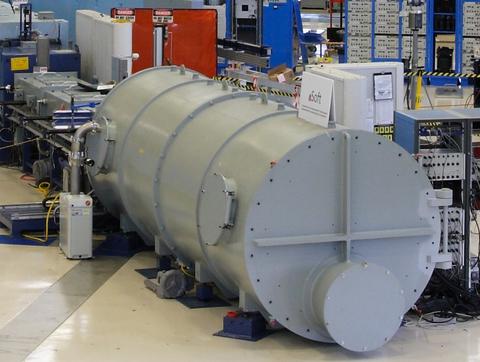10m SANS - Small Angle Neutron Scattering

The 10 meter Small Angle Neutron Scattering (10m SANS) instrument is designed to measure correlations in spatial structure within solid and liquid materials. The technique measures deflections of a neutron beam as it passes through a sample of interest. The spectrum of deflected neutrons reveals important details such as the state of the material (i.e. amorphous, crystalline, semi-crystalline, liquid crystalline, or some combination), how composition is distributed relative to other structures (i.e. the location of water relative to a membrane pore, or a surfactant relative to a protein in a biopharmaceutical), and how structure evolves with processing parameters that are critical to end applications. For the latter point, the instrument provides ample space for sample environment, allowing the installation of, for example, a rheometer that will measure the response of a fluid under shear while the SANS data provides the concurrent change in liquid structure. These types of measurements allow structural observations to be intimately connected to processes used in manufacturing, including shear, high pressure, high temperature, and environmental exposure. As such, SANS is a foundational technique for the development of structure-property-performance relationships in solid materials, liquids, and mixtures.
The 10m SANS is constructed in much the same manner as the two 30 meter SANS instruments available at the NCNR, with the primary difference being the overall maximum length (10 meters vs. 30 meters). The primary difference in the instrument is the model of operation. The 10m SANS is operated by the NIST nSoft consortium (www.nist.gov/nsoft) which partners NIST scientists with staff from member companies. It is the intention of the NCNR that activities on the 10m SANS are performed for the benefit of the consortium. This includes experiments performed with member companies as well as measurement development activities that provide new or enhanced capabilities for members. Users who wish to access the 10m SANS are encouraged to consider the criteria above and contact one of the instrument scientists.
Specifications/Capabilities
|
Q-Range |
0.03 nm-1 to 6.0 nm-1 |
| Size Regime | 1 nm to 200 nm |
| Source | Neutron Guide (NG-B), cross-section: 60 mm x 60 mm |
| Monochromator | Mechanical velocity selector with variable speed and pitch |
| Wavelength Range | 4.0 Å to 20.0 Å |
| Wavelength Resolution | 9% to 30% Δλ/λ (FWHM) |
| Source-to-Sample Distance | 3.0 m to 1 m via insertion of guide sections |
| Collimation | Circular pinhole collimation |
| Sample Size | 0 mm to 25 mm diameter |
| Sample-to-Detector Distance | 1.3 m to 5.2 m continuously variable |
| Detector | 640 mm x 640 mm 3He position-sensitive proportional counter with a 5.08 mm x 5.08 mm resolution |

